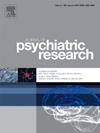Blast injury and chronic psychiatric disability in military personnel: Exploring the association beyond posttraumatic stress disorder
IF 3.7
2区 医学
Q1 PSYCHIATRY
引用次数: 0
Abstract
Introduction
Blast injuries are common among military personnel, yet their long-term psychiatric consequences, beyond posttraumatic stress disorder (PTSD) and traumatic brain injury (TBI), remain underexplored. This study investigates the association between blast injuries and non-PTSD psychiatric conditions, including psychotic, neurocognitive, mood, anxiety, adjustment and personality disorders resulting in functional impairment.
Methods
Data were collected from three cross-referenced registries that span the continuum of trauma care from 2006 to 2021. Demographics, injury mechanisms, and injury settings were sourced from the Israel Defense Forces Trauma Registry; hospitalization data from the Israeli National Trauma Registry and psychiatric-related disability was assessed utilizing long-term disability claims documented by the Israel Ministry of Health Rehabilitation Department. Logistic regression was employed to evaluate the association between blast injuries and psychiatric morbidity, with results presented as adjusted odds ratios (OR) and 95 % confidence intervals (CI).
Results
Among 7646 military personnel (91.3 % male, median age: 20 years), 1503 (19.7 %) sustained blast injuries. Overall, 44 (0.6 %) were diagnosed with non-PTSD psychiatric-related disability. Prevalence was higher among those with blast injuries (1.0 % vs. 0.5 %; p = 0.016). Blast injuries were associated with a more than two-fold increase in odds for psychiatric morbidity (Adjusted OR 2.44, 95 % CI: 1.07–5.59) after adjusting for blast injury severity and presence of head injury.
Conclusions
Blast injury was significantly associated with long-term psychiatric morbidity, independent of head injury and additional confounders. These findings suggest that proactive mental health screening and interventions should be considered for individuals experiencing blast injuries. Future research should explore the mechanisms underlying this association.

军事人员爆炸伤害与慢性精神残疾:探索创伤后应激障碍之外的关联
爆炸伤害在军事人员中很常见,但其长期精神后果,除了创伤后应激障碍(PTSD)和创伤性脑损伤(TBI),仍未得到充分研究。本研究探讨爆炸伤害与非创伤后应激障碍精神疾病的关系,包括精神病、神经认知、情绪、焦虑、适应和人格障碍导致的功能障碍。方法数据收集自2006年至2021年期间跨越创伤护理连续体的三个交叉参考注册中心。人口统计数据、损伤机制和损伤设置来源于以色列国防军创伤登记处;利用以色列卫生部康复司记录的长期残疾索赔,评估了以色列国家创伤登记处和精神相关残疾的住院数据。采用Logistic回归来评估爆炸伤害与精神疾病发病率之间的关系,结果以校正优势比(OR)和95%置信区间(CI)表示。结果7646名军人(男性91.3%,中位年龄20岁)中有1503人(19.7%)遭受爆炸伤害。总体而言,44人(0.6%)被诊断为非创伤后应激障碍精神相关残疾。爆炸伤患者的患病率更高(1.0%比0.5%;p = 0.016)。在调整爆炸损伤严重程度和头部损伤后,爆炸损伤与精神疾病发病率增加两倍以上相关(调整OR 2.44, 95% CI: 1.07-5.59)。结论爆炸伤与长期精神疾病发病率显著相关,与头部损伤和其他混杂因素无关。这些发现表明,应该考虑对遭受爆炸伤害的个体进行积极的心理健康筛查和干预。未来的研究应该探索这种关联背后的机制。
本文章由计算机程序翻译,如有差异,请以英文原文为准。
求助全文
约1分钟内获得全文
求助全文
来源期刊

Journal of psychiatric research
医学-精神病学
CiteScore
7.30
自引率
2.10%
发文量
622
审稿时长
130 days
期刊介绍:
Founded in 1961 to report on the latest work in psychiatry and cognate disciplines, the Journal of Psychiatric Research is dedicated to innovative and timely studies of four important areas of research:
(1) clinical studies of all disciplines relating to psychiatric illness, as well as normal human behaviour, including biochemical, physiological, genetic, environmental, social, psychological and epidemiological factors;
(2) basic studies pertaining to psychiatry in such fields as neuropsychopharmacology, neuroendocrinology, electrophysiology, genetics, experimental psychology and epidemiology;
(3) the growing application of clinical laboratory techniques in psychiatry, including imagery and spectroscopy of the brain, molecular biology and computer sciences;
 求助内容:
求助内容: 应助结果提醒方式:
应助结果提醒方式:


